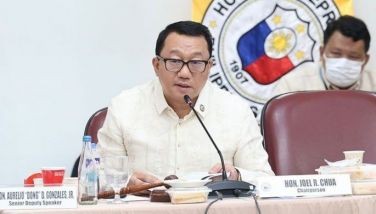NDRRMC called out for deficiencies in P6.3B geohazard program
January 23, 2017 | 9:57pm

The Commission on Audit said the National Disaster Risk Reduction and Management Council failed to conduct proper coordination with government agencies involved in disaster risk reduction and management planning.
File
MANILA, Philippines — The Commission on Audit (COA) has called out the National Disaster Risk Reduction and Management Council (NDRRMC) for several deficiencies in the implementation of the government's P6.3-billion Geohazard Mapping and Assessment Program (GMAP) for years 2013 to 2015.
In its 33-page performance audit report on GMAP, the COA said the NDRRMC as the head agency for the program's implementation, failed to conduct proper coordination with government agencies involved in disaster risk reduction and management planning.
The COA said the NDRRMC also failed to conduct proper monitoring of the geohazard mapping project to ensure its accuracy and timeliness.
The copy of the report was transmitted to the office of Defense Secretary Delfin Lorenzana, who also served as NDRRMC chairman on Dec. 14, 2016.
Based on the audit body's records from 2013 to 2015, the government allocated a total of P6.363 billion in the implementation of GMAP which was composed of three major components — the digitized Unified Mapping Project (P1.9 billion), the Project Nationwide Operational Assessment of Hazards or Project NOAH (P3.2 billion) and Geohazard Mapping and Assessment Project or GhMAP (P1.2 billion)
Among the deficiencies noted by COA in the program's implementation was the lack of “coordination mechanisms among Council members, lead agencies, and implementing partners, particularly on disaster prevention and mitigation.”
The COA said that while the NDRRMC has issued several memorandum circulars on disaster preparedness and response, there were no issued guidelines on proper coordination, which would have aided in defining and synchronizing the government agencies' “roles/functions towards the effective implementation of the NDRRMP (National Disaster Risk Reduction Management Plan).”
Further, the COA said the conceptualization and planning for the geohazard mapping project undertaken by the Department of Environment and Natural Resource's Mines and Geosciences Bureau (MGB) was not subjected to review and monitoring by the Department of Science and Technology (DOST) and the NDRRMC's Office of the Civil Defense (OCD) to ensure that it was in line with the NDRRMP.
The audit body said there was also no clear-cut policy guidelines or procedure on updating of the geohazard maps in order to produce ones “with the most accurate and relevant hazard information.”
“Due to rapid development/changes in the nature and risk level of hazards, updating of the hazard maps as the need arises is necessary in order to produce maps with the most accurate hazard information as vital tool in disaster prevention and mitigation,” the COA said.
The audit body, however, acknowledged the MGB's initiatives in updating the maps last year and on conducting information, education and communication (IEC) campaigns in several local government units on the maps' importance and how they are used.
The COA noted that the MGB was able to conduct IEC drive in 7,029 barangays in 2015 exceeding its target of 5,802 barangays for the year. The MGB aims to cover 42,036 barangays nationwide from 2015 to 2017 on the use of geo-hazard maps.
“The geohazard maps are generally utilized by the LGUs... which contribute to the reduction of vulnerabilities and exposure of communities in case of disasters for a more rational local development,” the report read.
“However, there is still a need to adopt clear-cut policy guidelines or procedure on updating of the geohazard maps in order to produce maps with the most accurate and relevant hazard information,” it added.
The audit body said that the OCD, should have proposed to Congress an additional budget for monitoring equipment and personnel instead of yearly asking for higher Quick Response Fund (QRF) which under the law can only be utilized in times of emergency.
“Thus, considering that the QRF could not be used for the OCD’s monitoring functions, low utilization thereof was noted in the years 2013 to 2015 and resulted in the reversion of unutilized balance of P465.985 million as of 31 December 2015,” the report read.
“This indicates that the OCD failed to request the appropriate budget it needs to be able to fully perform its mandated functions,” it added.
BrandSpace Articles
<
>
Philstar
- Latest
- Trending
Trending
Latest
Trending
Latest
Recommended































